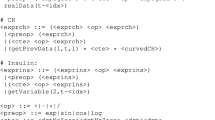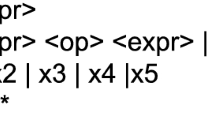Abstract
Currently, Diabetes Mellitus Type 1 patients are waiting hopefully for the arrival of the Artificial Pancreas (AP) in a near future. AP systems will control the blood glucose of people that suffer the disease, improving their lives and reducing the risks they face everyday. At the core of the AP, an algorithm will forecast future glucose levels and estimate insulin bolus sizes. Grammatical Evolution (GE) has been proved as a suitable algorithm for predicting glucose levels. Nevertheless, one the main obstacles that researches have found for training the GE models is the lack of significant amounts of data. As in many other fields in medicine, the collection of data from real patients is very complex. In this paper, we propose a data augmentation algorithm that generates synthetic glucose time series from real data. The synthetic time series can be used to train a unique GE model or to produce several GE models that work together in a combining system. Our experimental results show that, in a scarce data context, Grammatical Evolution models can get more accurate and robust predictions using data augmentation.
Similar content being viewed by others
Notes
- 1.
On 6 June 2012, the Clinical Research Ethics Committee of the Hospital of Alcalá de Henares (Spain) authorized the use of the data collected, provided that the privacy of the data is ensured and the informed consent of patients is made.
References
Krinsley, J.S., Jones, R.L.: Cost analysis of intensive glycemic control in critically ill adult patients. Chest 129(3), 644–650 (2006)
Nicolao, G.D., Magni, L., Man, C.D., Cobelli, C.: Modeling and control of diabetes: towards the artificial pancreas. In: 18th IFAC World Congress of the IFAC Proceedings Volumes, vol. 44, no. 1, pp. 7092–7101 (2011)
Hastings, W.: Monte Carlo sampling methods using Markov chains and their applications. J. Biometrica 57, 97–109 (1970)
Tanner, M.A., Wong, W.H.: From EM to data augmentation: the emergence of MCMC Bayesian computation in the 1980s, April 2011. arXiv e-prints arXiv:1104.2210
Yadav, M., Malhotra, P., Vig, L., Sriram, K., Shroff, G.: ODE - augmented training improves anomaly detection in sensor data from machines. CoRR (2016). arXiv:1605.01534
Kumar, A., Cowen, L.: Augmented training of hidden Markov models to recognize remote homologs via simulated evolution. Bioinformatics 25(13), 1602–1608 (2009)
Mays, L.: Diabetes mellitus standards of care. Nurs. Clin. North Am. 50(4), 703–711 (2015). Pathophysiology and Care Protocols for Nursing Management
Messori, M., Toffanin, C., Favero, S.D., Nicolao, G.D., Cobelli, C., Magni, L.: Model individualization for artificial pancreas. Comput. Methods Programs Biomed. (2016, in press). http://dx.doi.org/10.1016/j.cmpb.2016.06.006
Kastorini, C.-M., Papadakis, G., Milionis, H.J., Kalantzi, K., Puddu, P.-E., Nikolaou, V., Vemmos, K.N., Goudevenos, J.A., Panagiotakos, D.B.: Comparative analysis of a-priori and a-posteriori dietary patterns using state-of-the-art classification algorithms: a case/case-control study. Artif. Intell. Med. 59(3), 175–183 (2013)
Hidalgo, J.I., Maqueda, E., Risco-Martín, J.L., Cuesta-Infante, A., Colmenar, J.M., Nobel, J.: GlUCmodel: a monitoring and modeling system for chronic diseases applied to diabetes. J. Biomed. Inform. 48, 183–192 (2014)
Yu, C., Zhao, C.: Rapid model identification for online glucose prediction of new subjects with type 1 diabetes using model migration method. In: IFAC World Congress of the IFAC Proceedings Volumes, vol. 47, no. 3, pp. 2094–2099 (2011)
Gevers, M.: Identification for control: from the early achievements to the revival of experiment design. Eur. J. Control 11(4), 335–352 (2005)
Pelikan, M., Mühlenbein, H.: Marginal distributions in evolutionary algorithms. In: Proceedings of the International Conference on Genetic Algorithms Mendel, vol. 98, pp. 90–95. Citeseer (1998)
Mühlenbein, H.: The equation for response to selection and its use for prediction. Evol. Comput. 5, 303–346 (1997)
O’Neill, M., Ryan, C.: Grammatical Evolution: Evolutionary Automatic Programming in an Arbitrary Language. Kluwer Academic Publishers, Norwell (2003)
Clarke, W., Cox, D., Gonder-Frederick, L., Carter, W., Pohl, S.: Evaluating clinical accuracy of systems for self-monitoring of blood glucose. Diabetes Care 10, 622–628 (1987)
Shapiro, S.S., Wilk, M.B.: An analysis of variance test for normality (complete samples). Biometrika 3(52), 591–611 (1965)
Acknowledgment
This research is supported by the Spanish Minister of Science and Innovation (TIN2014-54806-R).
The authors would like to thank the staff in the Principe de Asturias Hospital at Alcala de Henares for their support and assistance with this project. Special thanks also go to Maria Aranzazu Aramendi Zurimendi and Remedios Martinez Rodriguez.
Author information
Authors and Affiliations
Corresponding author
Editor information
Editors and Affiliations
Rights and permissions
Copyright information
© 2017 Springer International Publishing AG
About this paper
Cite this paper
Velasco, J.M. et al. (2017). Enhancing Grammatical Evolution Through Data Augmentation: Application to Blood Glucose Forecasting. In: Squillero, G., Sim, K. (eds) Applications of Evolutionary Computation. EvoApplications 2017. Lecture Notes in Computer Science(), vol 10199. Springer, Cham. https://doi.org/10.1007/978-3-319-55849-3_10
Download citation
DOI: https://doi.org/10.1007/978-3-319-55849-3_10
Published:
Publisher Name: Springer, Cham
Print ISBN: 978-3-319-55848-6
Online ISBN: 978-3-319-55849-3
eBook Packages: Computer ScienceComputer Science (R0)




